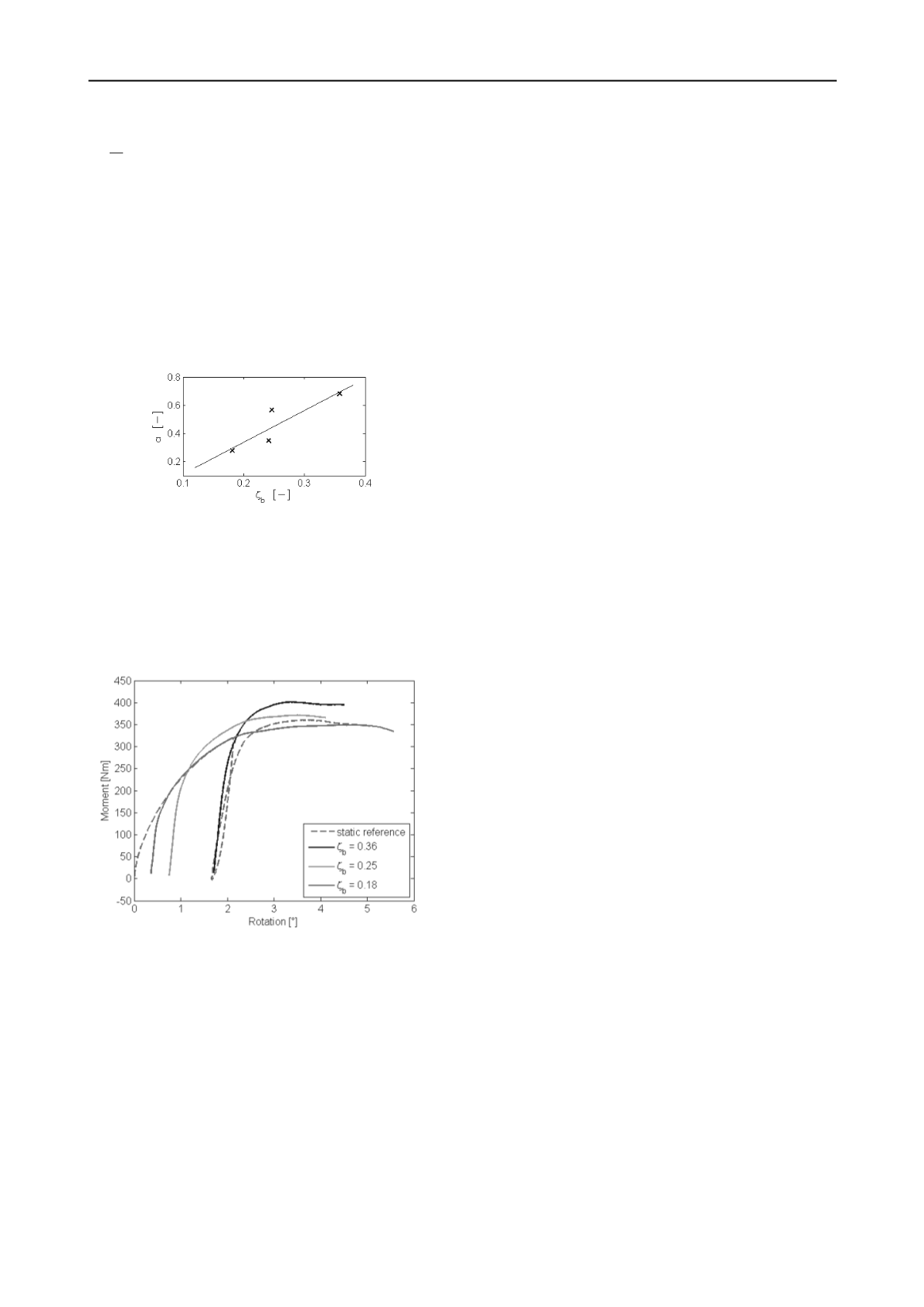
2394
Proceedings of the 18
th
International Conference on Soil Mechanics and Geotechnical Engineering, Paris 2013
Proceedings of the 18
th
International Conference on Soil Mechanics and Geotechnical Engineering, Paris 2013
=
(2)
and
are dimensionless constants determined empirically
from the tests. The results from the long-term one-way loading
cf. Figure 5 shows a general good agreement with the power
function even though deviations in the first 1000 cycles are
observed. The values for the power
are found to be similar for
all the tests with values in the range of 0.11 to 0.18. These
values are found to be smaller than the value of 0.31 as
presented by LeBlanc et al. (2010). The results for the constant
cf. Figure 6 indicates that
depends linearly of the magnitude
of the loading
which is in agreement with the findings in
LeBlanc et al. (2010).
Figure 6. Fitted empirical constant
as a function of the loading
magnitude
in the four cyclic tests.
The influence of the cyclic loading on the static lateral
capacity is evaluated by means of the results from the three
static tests performed post cyclic loading cf. Figure 7. The
maximum moments obtained indicates that the lateral capacity
depends on the cyclic loading and increases with increasing
load magnitude.
Figure 7. Moment-rotation relationships obtained in the static tests post
cyclic loading compared with the reference static test.
4 CONCLUSION
This paper presents a description of a 1g laboratory small scale
test setup for modelling laterally long-term cyclic loading of a
stiff pile in saturated dense sand. A static loading test and four
one-way cyclic loading tests with maximum moment loading
equal to 18% to 36% of the maximum static capacity are
presented. The purpose of the tests is to evaluate the influence
of the number of load cycles on the accumulated rocking
rotation of the pile at seabed during long-term cyclic loading. In
addition the effect of the cyclic loading on the static lateral
capacity is evaluated by means of static loading tests conducted
post cyclic loading.
All the tests are carried out with an open ended aluminium
pipe pile scaled approximately 1:50 in relation to a typical
monopile foundation for an offshore wind turbine. In the four
cyclic tests more than 50 000 load cycles are applied to the pile.
When evaluating the cyclic tests the accumulated rotation
normalised with respect to the rotation obtained in the first
loading cycles is used. The results reveal that the accumulation
of rotation during long-term cyclic loading can be described by
use of a power function. Further, the maximum moments
obtained in the static tests conducted post cyclic loading
indicates that the lateral capacity depends on the cyclic loading
and increases with increasing load magnitude.
The entire test setup is still in the initial phase of testing and
can be improved even more. Thus, the findings inhere must be
evaluated further and supplemented with additional testing with
varied loading characteristics, i.e. varied
and
for both one-
and two-way loading.
5 ACKNOWLEDGEMENTS
This research is associated with the EUDP programme
“Monopile cost reduction and demonstration by joint applied
research” funded by the Danish energy sector. The financial
support is sincerely acknowledged.
6 REFERENCES
Achmus, M., Abdel-Rahman, K. and Peralta, P. 2005. On the design of
monopile foundations with respect to static and quasi-static loading.
Copenhagen Offshore Wind 2005.
Achmus, M., Albiker, J. and Abdel-Rahman, K. 2011. Investigations on
the behaviour of large diameter piles under cyclic lateral loading.
In:
Frontiers in Offshore Geotechnics II
- Gourvenev & White
(eds), Taylor & Francis Group, LLC.
DNV 2010. Offshore standard DNV-OS-J101: Design of offshore wind
turbine structures,
Technical report DNV-OS-J101
, Det Norske
Veritas.
Ibsen, L. B., Hanson, M. Hjort, T. and Taarup, M. 2009.
MC-parameter Calibration of Baskarp Sand No. 15,
DCE Technical
Report No. 62.
Department of Civil Engineering, Aalborg
University
LeBlanc, C., Houlsby, G. and Byrne, B. 2010. Response of stiff piles to
long-term cyclic lateral load,
Géotechnique,
60 (2), pp. 79-90.
Long J. H. and Vanneste G. 1994. Effects of Cyclic Lateral Loads on
Piles in Sand.
Journal of Geotechnical Engineering
, 120 (1), pp.
225-244.
Niemunis,A., Wichtmann, T. and Triantafyllidis, T. 2005. A high-cycle
accumulation model for sand,
Computer and Geotechnics,
32 (4),
pp. 245-263.
Peng, J.-R., Clarke, B. G. and Rouainia, M. 2006. A device to Cyclic
Lateral Loaded Model Piles,
Geotechnical Testing Journal
29 (4)
pp. 1-7
.
Peralta, P. and Achmus, M. 2010. An experimental investigation of
piles in sand subjected to lateral cyclic loads,
7th International
Conference on Physical Modeling in Geotechnics
, Zurich,
Switzerland.
Poulus H., and Hull T. 1989. The Role of Analytical Geomechanics in
Foundation Engineering.
Foundation Engineering.: Current
Principles and Practices
, 2, pp. 1578-1606.
Roesen, H. R., Thomassen, K., Sørensen, S. P. H., and Ibsen, L. B.,
2010. Evaluation of Small-Scale Laterally Loaded Non-Slender
Monopiles in Sand
DCE Technical Report No. 91
, Aalborg
University. Department of Civil Engineering.
Roesen, H. R., Ibsen, L. B., and Andersen, L. V. 2012. Small-Scale
Testing Rig for Long-Term Cyclically Loaded Monopiles in
Cohesionless Soil,
Proceedings of the 16
th
Nordic Geotechnical
Meeting
, Copenhagen, 9-12 May, 2012, vol. 1/2, p.435-442..
Wichtmann, T., Niemunis, A. and Triantafyllidis, T. 2008. Prediction of
long-term deformations for monopile foundations of offshore wind
power plants.
11
th
Baltic Sea Geotechnical Conference:
Geotechnics in Maritime Engineering
, Gdansk, Poland.


